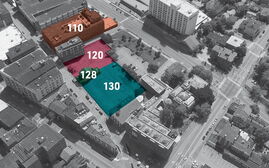Union membership is up in Maine, while nonunion employment is down
 File Photo / William Hall
Members of a machinists union at Bath Iron Works last June launched a walkout that lasted nine weeks. Here, they picket outside the shipyard, near the union hall, shown in background.
File Photo / William Hall
Members of a machinists union at Bath Iron Works last June launched a walkout that lasted nine weeks. Here, they picket outside the shipyard, near the union hall, shown in background.
Membership in labor unions appears to be on the upswing in Maine and outpaced a national trend during 2020, a new federal report shows.
The number of union members in the state grew from 69,000 to 82,000 last year, representing an increase from 11.8% of Maine’s workforce to 14.7%, according to data released last week by the U.S. Bureau of Labor Statistics.
Nationwide, 10.8% of workers held union memberships during 2020, up only slightly from 10.3% in 2019.
The Maine AFL-CIO, a federation of 160 local unions representing over 40,000 Maine workers, attributed the growth to a combination of factors, including organizing of new unions and greater organizing within existing ones.
“More and more Maine workers are organizing and fighting for better wages, working conditions, safety on the job and democracy in the workplace,” said Maine AFL-CIO President Cynthia Phinney in a news release.
“The pandemic has reminded all of us that working people are essential. The best way for essential workers to have safe workplaces, respect at work and good jobs is by joining together with coworkers in a union.”
But one of the big reasons for the big increase has also been “significant layoffs in non-union sectors of the economy due to COVID,” the union acknowledged.
In fact, the federal data show 559,000 Mainers were employed last year, 29,000 fewer than in 2019. Much of decrease has taken place across fields where Maine workers are largely nonunionized, such as the hospitality industry and retail businesses.
The BLS report warns: “Comparisons with union membership measures for earlier years, including metrics such as the union membership rate and the median usual weekly earnings of union members, should be interpreted with caution … These increases reflect the disproportionately large decline in total wage and salary employment (mostly among nonunion workers) compared with the decline in the number of union members.”
Nationwide, 14.3 million workers were union members in 2020, a decline of 321,000, or 2.2%, from the 2019 total, the report notes.
Those levels are far less than the numbers in 1983, the first year for which comparable union data are available, when union membership represented 20.1% of the workforce and there were 17.7 million union workers.
More recently, there’s been a decline since a 2018 U.S. Supreme Court decision forbade unions to require “fair share” fees — in effect, partial dues — from workers who were not full members, but covered by collective bargaining agreements.
According to a Bloomberg report, the decision led to drops in membership for some unions, including three of the country’s largest: the Teamsters, United Food and Commercial Workers, and United Steelworkers.
In Maine, several labor unions have made headlines in recent months, including a machinists organization that struck Bath Iron Works for two months last summer and organizing attempts at the Portland Museum of Art and at Maine Medical Center.
At BIW, about 4,300 workers walked off their jobs after a bitter contract dispute. Represented by Local S6 of the International Association of Machinists & Aerospace Workers, the strike was the second-largest work stoppage in the U.S. last year, according to other new data from the federal bureau.
The union members returned to work in August after approving a new contract. The strike was the local’s longest and the first since 2000.













0 Comments